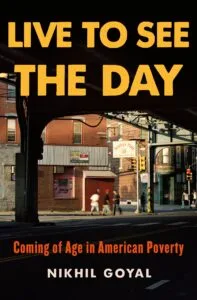The reason I appreciated Nikhil Goyal’s new book, Live to See the Day, so much was that he refocused the national debate about how to improve schools. For the past three decades or more, we have heard from politicians, pundits, major philanthropists, and self-proclaimed reformers that the way to “fix” schools is to standardize the curriculum and tests, make tests harder, test more frequently, fire teachers and principals if schools don’t get higher test scores, and replace public schools with charter schools and vouchers.
We now know, after a quarter-century of this approach, which I call “test and punish,” that it doesn’t work. It doesn’t work because it ignores the conditions in which students live. The great virtue of Nikhil’s book is that he identifies what matters most. Help families, communities, and students to thrive, and schools will benefit.
—Diane Ravitch
*
Diane Ravitch: What led you to writing Live to See the Day and what did the research entail?
Nikhil Goyal: I had been interested in examining the high school dropout crisis. I found that many of the books and writings on the subject trafficked in blame-the-victim narratives rather than pinpoint the structural causes behind why students leave school before graduating. So I thought I could make an important contribution to the field of study. I had a chat with my friend Andrew Frishman, co-executive director of the non-profit organization Big Picture Learning, and asked him to suggest schools in his network for me to visit. I ended up getting connected with David Bromley, who started El Centro de Estudiantes, an alternative, student-centered high school for students who had dropped out in Kensington, the poorest neighborhood of Philadelphia.
What initially was going to be a story about the school turned into an eight-year ethnographic study that examined the lives and educational experiences of youth who had dropped out, or more accurately, been pushed out of school in the city; the relationship between market-based school reform, hyperincarceration, deep poverty, and urban political economy; and the historical legacies of welfare reform, deindustrialization, and the war on drugs in Kensington. I was embedded in the neighborhood, where I conducted hundreds of interviews and surveys and thousands of hours of observation. I also buried my head in several archives such as the Library Company of Philadelphia, Historical Society of Pennsylvania, and Temple Urban Archives. This became my PhD dissertation, and I turned that into a narrative nonfiction book.
DR: In the book, we meet three incredible young people: Ryan, Emmanuel, and Giancarlos. They had dropped out of school and later attended El Centro de Estudiantes. Why did you choose them?
NG: Each of the three main characters illustrate the cruelties of American-style market fundamentalism, criminal justice, and schooling—whether it was Emmanuel enduring multiple evictions and housing instability, Ryan enduring harsh punishment in the juvenile justice system and an alternative disciplinary school, or Giancarlos enduring zero-tolerance school discipline and budget cuts. They were also willing to give me access to their lives and families, which facilitated the difficult reporting. I am so grateful for their time and contributions.
DR: There have been many books written about urban education and poverty. How is yours different?
NG: Three decades ago, writer Alex Kotlowitz narrated the beautiful and harrowing stories of two African-American brothers growing up in decrepit, segregated public housing projects in Chicago. In part, my book picks up where he left off by providing the first, extensive narrative nonfiction account of the lives of poor children and their families in the era of welfare reform, the Great Recession, a raging opioid epidemic, and the rise of the carceral state. Unlike many texts, I also discussed public education in the lens of political economy and public policy: poverty, evictions, food insecurity, the lack of decent health care, and other issues. I thought it would be a disservice to these young people if I simply told their stories, evoked pity from readers, and called it a day. We must call out structural violence if we are to improve the material conditions of neighborhoods like Kensington. Finally, I provided an intergenerational account by detailing the lives of the mothers of the three youth. I think that is a novel approach.
I thought it would be a disservice to these young people if I simply told their stories, evoked pity from readers, and called it a day.
DR: What is your assessment of charter schools and the Biden administration’s record on public education?
NG: We have both written extensively about how the charter school movement was hijacked by billionaires, philanthropists, and corporate school reformers to advance their mission of privatizing, defunding, and undermining public education. As I detail in the book, Philadelphia has been a guinea pig in this radical crusade: austerity measures, school closures, charter expansion, and exclusionary school discipline. As of October 2022, nearly forty percent of students attended charter and cyber charter schools. The exodus from the public system will continue unless the next Mayor reverses course. You, me, and our good friend Carol Burris have been advocating to cut off funding for the federal Charter School Program, which has been riddled with widespread fraud, corruption, and mismanagement and bankrolled hundreds of for-profit charters across the nation. While the Biden administration did not slash funding, it made significant reforms that will virtually prevent for-profit charter operators from feeding off the largesse of federal dollars. It is remarkable to reflect upon the transformation of education policy in just the past decade. The once bipartisan war on public education has now been repudiated by much of the Democratic Party.
DR: For the past two years, you worked as the senior policy advisor on education and children for Senator Bernie Sanders. You joined shortly after President Joe Biden took office and Democrats secured a historic trifecta: the presidency, House, and Senate. Tell us about your experience working on the Build Back Better legislation.
The question I wonder about the most is: How can we renew the spirit of the New Deal?
NG: When I was working on Build Back Better as a staffer on the Senate Committee on the Budget in 2021, I really felt like we had the power to “begin the world again”—to draw on Thomas Paine. We set out to create a robust social democracy. I often revisited writings about President Franklin Delano Roosevelt’s New Deal and its architects. I tried to imagine how they confronted wretched conditions with the titanic weight of history on their shoulders: one in four people out of work, millions going hungry, families losing their homes and entire savings while fascism and authoritarianism was on the march in Europe. If they failed to appropriately respond, the American democratic experiment was at risk of collapsing. It is remarkable to comprehend the breadth of their achievements and influence on our society that stretches to modern times: Social Security, banking regulations, investments in public schools, libraries, parks, post offices, airports, and other infrastructure, federal minimum wage, collective bargaining rights, public housing, Federal Writers, Art, and Theater Projects, and much more. They saved democracy.
Our reconciliation bill was whittled down from $6 trillion to $3.5 trillion to $1.75 trillion. It was incredibly disappointing to fall one vote shy of passing affordable child care, universal preschool, expanded child tax credit, housing investments, and other social and economic policies. The fight goes on. And I am very proud of the Inflation Reduction Act, which is beginning to reduce carbon emissions, cut energy bills, and lower the cost of prescription drugs.
Sadly, your former husband Richard Ravitch recently passed away, and you penned a moving tribute to his extraordinary life. As you wrote, “Never lose sight of the goal, which is the betterment of life for all people. He loved New York City, New York State, and America, and he wanted to make them better. He was a disciple of FDR to the end.” For decades, our nation’s leaders assailed the New Deal order and kowtowed to corporate interests and subscribed to a doctrine of unfettered markets. The question I wonder about the most is: How can we renew the spirit of the New Deal?
DR: What do you hope people will do after reading your book?
NG: By the end, I expect readers will recognize that poverty is a crime against humanity and it is a moral outrage that tens of millions of people are deprived of the basic necessities of a dignified life in the richest nation on the planet. With this knowledge, I encourage people to directly engage in mass politics and collective action. As the physician and anthropologist Paul Farmer taught us, we have a moral duty to reduce suffering. My plea is: Join social movements, organize your workplaces, walk picket lines in solidarity with workers on strike, run for office, knock on doors to support campaigns and ballot initiatives, and vote for Democrats who champion universal public goods and act in service of the hungry, the poor, the sick, the marginalized, and the workers of this beautiful country.
__________________________
Live to See the Day: Coming of Age in American Poverty by Nikhil Goyal is available from Metropolitan Books, an imprint of Macmillan, Inc.



